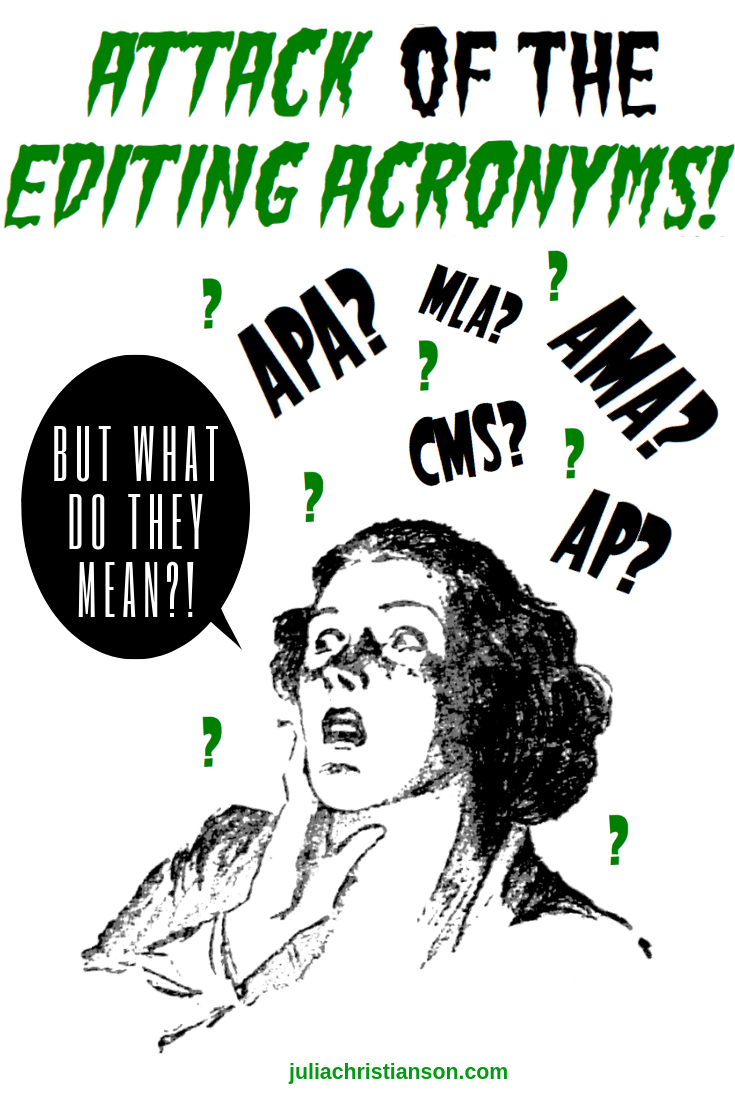Attack of the Editing Acronyms!
You’re looking for an editor. You’ve finished your text, and you’re ready to get it polished and ready to publish! But as you scan through editors’ bios and websites, your head starts to spin. Acronyms, acronyms everywhere! Do you want someone with the most acronyms? Do you want someone who specializes in only one acronym? How the heck are you supposed to know which one suits your needs?
Fear not! Although editing acronyms can be confusing, with a little patience and a some information you’ll soon be able to identify at a glance whether or not a certain editor is experienced in your field and can help you with your project.
Style Guides and Your Work
Editing acronyms frequently provide a shorthand to educate you about which style guides an editor is familiar with, and whether that editor can provide professional work related to your text. Style guides are generally accepted “correct” ways of presenting information in different fields.
Style and formatting vary between style guides, so citations in APA style are not the same at citations in MLA style. Moreover, there are rules about abbreviations, numbers, spellings, and many other facets of writing that change from field to field and guide to guide. Thus, knowing your field and the focus of your work is crucial to picking the correct guide, and the correct editor to apply it.
Four General Guides
AP (Associated Press) Stylebook: This guide is used for articles, especially those online and in formal publications like periodicals and newspapers. It’s an established guide that’s widely used for non-fiction writing.
APA (American Psychological Association), Publication Manual of: This guide is useful for science writing, especially publications with abstracts and a scientific organization. It’s widely recognized as an essential staple of this kind of writing.
CMS (Chicago Manual of Style): This is a fantastic overview that’s one of the most widely consulted editing guides in the business. This is nearly a catch-all for good editing practices and style.
MLA (Modern Language Association) Style Manual: This guide is used in academia and lower education such as secondary school. Those who are still in school, teachers or students, tend to favor this style guide.
Three Specialized Guides
AMA (American Medical Association) Manual of Style: This guide is used for medical writing and publications.
Handbook of Technical Writing: This guide is a general style guide that covers many aspects of writing technical documents for both an experience and a layman audience.
Turabian: This style guide is frequently used by graduate students working on their theses. Occasionally schools will use this instead of MLA for their standard.
For More Information
These guides are merely a select few among the many potential guides out there. When in doubt, contact the editor you are considering and ask them about their experience and what they would recommend as the prominent style guide for your work. A professional will give you accurate and helpful information to ensure that your work is presented correctly and as its best version possible.
You’ve conquered the acronyms! Now you can find the right editor for your project.
Interested in seeing what kind of editing I do? Check out my Services page for more information.
